bridge

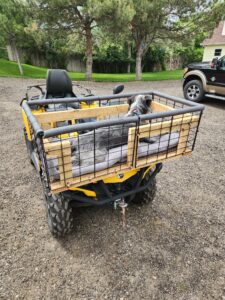 My brother-in-law, Chris Hadlock loves to take his family camping in the Big Horn Mountains. They try to make it an annual family event. They enjoy the camping, fishing, 4-wheeling, and probably the biggest thing…resting!! When they go, they usually have everyone’s dogs with them, and Chris built a rack for the 4-wheeler, so that their dog, Liberty can go with them. It can’t be fun for the dogs to sit around camp alone while everyone is out on the trails. Earlier this year, Chris and my sister, Allyn Hadlock bought a new trailer, and while this was their second camping trip with it, they are still figuring things out, which is common with a new unit. Mostly its figuring out the stuff they need and don’t need. When they go camping, they want to be completely “off the grid” where there is no phone service and no email, text, or
My brother-in-law, Chris Hadlock loves to take his family camping in the Big Horn Mountains. They try to make it an annual family event. They enjoy the camping, fishing, 4-wheeling, and probably the biggest thing…resting!! When they go, they usually have everyone’s dogs with them, and Chris built a rack for the 4-wheeler, so that their dog, Liberty can go with them. It can’t be fun for the dogs to sit around camp alone while everyone is out on the trails. Earlier this year, Chris and my sister, Allyn Hadlock bought a new trailer, and while this was their second camping trip with it, they are still figuring things out, which is common with a new unit. Mostly its figuring out the stuff they need and don’t need. When they go camping, they want to be completely “off the grid” where there is no phone service and no email, text, or 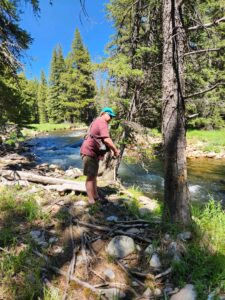 any other distractions. The main thing they want is to have all the kids with them, so it is a real family affair. There is just something about having all your kids together with you and nobody has any place they have to be. Everyone can really relax and enjoy the time together. They love it so much that they are planning several more, short trips around the state and maybe even over to the Black Hills.
any other distractions. The main thing they want is to have all the kids with them, so it is a real family affair. There is just something about having all your kids together with you and nobody has any place they have to be. Everyone can really relax and enjoy the time together. They love it so much that they are planning several more, short trips around the state and maybe even over to the Black Hills.
A while back, Chris and Allyn bought his parents place after his mom, Ramona Hadlock passed away in 2018. His dad, passed away in 1995. The place needed some big repairs, because the mobile home they had lived in was really old. So, they tore it down and built a really nice house in its place. Since then, they have continued to do repairs and improvements on the property. This year’s heavy rains necessitated the repair of the bridge that spans the creek they must cross to get into the house. The heavy rains narrowed the dirt bridge, so it was a necessary repair. They borrowed a backhoe from our brother-in-law, Mike Reed to do much of the heavy work. There will also be other improvements around the property, like fixing some fencing and finishing some of the road work.
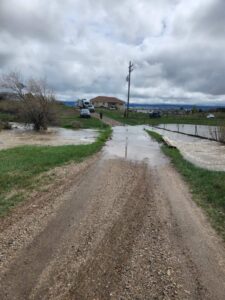

Chris has helped his parents with improvements on the property for years, so really, this is a continuation of the same things he has been doing for years. The place is a big property, so mowing is a big job, and it is best done on a riding lawnmower. Thankfully, they have one of those, because it would be a days-long job on foot. Little did Chris know, all those years ago, that the improvements he was making for his parents would someday be his to his own benefit. Still, even if it had not been to his benefit, he would have gone out and helped his parents, because that is the kind of guy he is. Today is Chris’ birthday. Happy birthday Chris!! Have a great day!! We love you!!
 Flood waters carry with them more damage than people imagine. Water just doesn’t seem like the force it can become. That was exactly what had happened in May of 1878. The flood waters came rushing down the creek overnight, and the force of the water had wiped out a bridge at Box Elder, Montana. The section foreman discovered the missing bridge and rushed to secure a red light for the purpose of signaling the Kansas Pacific freight train. He knew the train was due any minute. Before he could avoid the approaching disaster, the train thundered down upon the chasm left by the missing bridge, and into the torrent of wild waters below.
Flood waters carry with them more damage than people imagine. Water just doesn’t seem like the force it can become. That was exactly what had happened in May of 1878. The flood waters came rushing down the creek overnight, and the force of the water had wiped out a bridge at Box Elder, Montana. The section foreman discovered the missing bridge and rushed to secure a red light for the purpose of signaling the Kansas Pacific freight train. He knew the train was due any minute. Before he could avoid the approaching disaster, the train thundered down upon the chasm left by the missing bridge, and into the torrent of wild waters below.
The accident occurred about 12 o’clock that Tuesday night, three employees lost their lives, and a whole freight train was totaled. John Bacon, of Denver, who was the engineer; his fireman, Frank Sellvin, and another employee named John Piatt, were in the engine, and unable to escape. The whole train had eighteen cars. The fatal blow came when the car that was loaded with railroad iron, came to rest on top of the wreck, burying the men piled upon the wreck and buried the men. They might as well have been buried beneath a mountain. The crews knew it would be several days before they would be able to remove the bodies from the wreckage. Nevertheless, given the way the iron car fell on the engine, it was certain that the three men died instantaneously…or nearly so.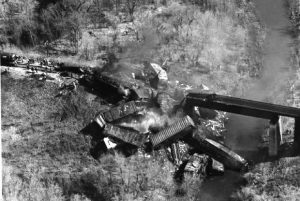
In a bizarre twist, the body of Frank Sellvin turned up, not under the wreckage, but a mile and a half from where that accident occurred. It appeared that he jumped from the engine as it fell. While trying to save himself, he was instead carried by the raging torrent out of the reach of the wreck, but not out of the clutches of the killer flood waters. By midnight the bodies of the other two men were still missing. It would be a while yet before their bodies would be found. Water seems like something so innocent, but when they become flood waters, they become killer waters.
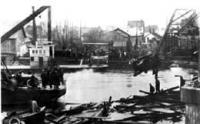 On January 3, 1923, the suspension bridge at Kelso, Washington was nearly finished…but it had not yet been opened, and the old bridge was still in use. The old bridge was just that…old, and they knew it, but until the new bridge was open, the old bridge was all they had. Both bridges spanned the Cowlitz River. Kelso was a small town, with a population of less that 2,000 people on the day in 1923.
On January 3, 1923, the suspension bridge at Kelso, Washington was nearly finished…but it had not yet been opened, and the old bridge was still in use. The old bridge was just that…old, and they knew it, but until the new bridge was open, the old bridge was all they had. Both bridges spanned the Cowlitz River. Kelso was a small town, with a population of less that 2,000 people on the day in 1923.
On that day, the bridge, which was a major roadway in the area was experiencing a traffic jam, due to a stalled car in the middle. To further complicate matters, there was a crowd of people in the area who had gathered to watch a log jam. The combined congestion on the bridge caused the cable that held the bridge up give way. Approximately 100 people were thrown into the flooded and rushing river. The collapse happened at night, making rescue and recovery very difficult. No bodies were 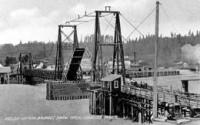 located that first night, and 20 to 30 people were said the be missing. About the same number of people had been rescued from the river with various injuries. To further complicate matters, a transformer in the electric plant had blown out, so there were no electric lights.
located that first night, and 20 to 30 people were said the be missing. About the same number of people had been rescued from the river with various injuries. To further complicate matters, a transformer in the electric plant had blown out, so there were no electric lights.
Two piers of heavy piling provided the foundations for the structure, which was of a bascule suspension type, this construction being necessary because of the fact that the Cowlitz is a navigable waterway. The two lift portions of the bridge meeting at the center were suspended by steel cables from two high wooden towers. With the exception of the steel cables the entire bridge was of wood. The collapsed span of the bridge had been supported by the cables, and when one of the supporting piers buckled under the weight of the traffic, the 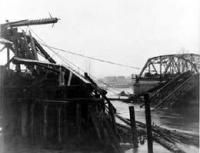 whole bridge went down. Normally the Cowlitz River is a narrow stream, but in times of high water, the river becomes very swift. In this sad instance, heavy rains had flooded the river.
whole bridge went down. Normally the Cowlitz River is a narrow stream, but in times of high water, the river becomes very swift. In this sad instance, heavy rains had flooded the river.
The town of Kelso was in chaos shortly after the crash. People were frantically searching for friends and family. Many rushed to the hospital in search of their people. I they didn’t find them there, they rushed back to the river. Adding to the chaos was the current blackout in the town. At one hospital an operation upon an accident victim was in progress as the lights there flickered. Those who were injured had a long road to recovery, and that was just from their injuries. Still, they were blessed. They lived.
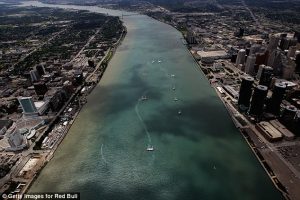 When a body of water stands between two places that people need to go, there are a few options to solve the dilemma…a bridge, a road around, or as was the case of a way across the Detroit River, a tunnel. With a river, you can’t really go around, so often it’s a bridge, but in this case there was a great deal of opposition to a bridge over the river. Since the beginning of the 19th century, Detroiters and Windsorians had been trying to find a way to move people and goods back and forth across the Detroit River. For decades, railroad interests proposed tunnels and bridges galore, but powerful advocates of marine shipping always managed to block those projects, because they did not want to lose business to faster and more capacious trains. Plans for bridges were particularly troubling to those shippers, since just one low-hanging bridge had the potential to keep high-masted sailing vessels off the river altogether.
When a body of water stands between two places that people need to go, there are a few options to solve the dilemma…a bridge, a road around, or as was the case of a way across the Detroit River, a tunnel. With a river, you can’t really go around, so often it’s a bridge, but in this case there was a great deal of opposition to a bridge over the river. Since the beginning of the 19th century, Detroiters and Windsorians had been trying to find a way to move people and goods back and forth across the Detroit River. For decades, railroad interests proposed tunnels and bridges galore, but powerful advocates of marine shipping always managed to block those projects, because they did not want to lose business to faster and more capacious trains. Plans for bridges were particularly troubling to those shippers, since just one low-hanging bridge had the potential to keep high-masted sailing vessels off the river altogether.
In 1871, the region’s railroads finally won permission to build a trans-national tunnel, and workers began to dig into the river at the foot of Detroit’s San Antoine Street. They were forced to abandon the project just 135 feet  under the river, however, when they struck a pocket of sulfurous gas that made workers so ill that none could be persuaded to return. Likewise, in 1879, another tunnel had to be abandoned when it ran right into some unexpectedly difficult to excavate limestone under the river. The first successful Michigan to Canada tunnel project finally opened in 1891. It was the 6,000 foot long Grand Trunk Railway Tunnel at Port Huron.
under the river, however, when they struck a pocket of sulfurous gas that made workers so ill that none could be persuaded to return. Likewise, in 1879, another tunnel had to be abandoned when it ran right into some unexpectedly difficult to excavate limestone under the river. The first successful Michigan to Canada tunnel project finally opened in 1891. It was the 6,000 foot long Grand Trunk Railway Tunnel at Port Huron.
Soon enough, it was clear to most people on both sides of the border that they needed to build some sort of structure for transporting automobiles across the river too. In June 1919, the mayors of Detroit and Windsor decided to build a city to city tunnel that would serve as a memorial to the American and Canadian soldiers who had died in World War I. Even after advocates of the under-construction Ambassador Bridge tried to frighten away the tunnel’s backers by spreading rumors about the danger of subterranean carbon monoxide poisoning, the tunnel boosters were undeterred. One said, they were “inspired by God to have this tunnel built.” Construction began in 1928. First, barges were used to dredge a 2,454 foot long trench across the river. Then workers sank nine 8,000 ton steel and concrete tubes into the trench and welded them together. Finally, an  elaborate ventilation system was built to make sure that the air in the tunnel safe to breathe.
elaborate ventilation system was built to make sure that the air in the tunnel safe to breathe.
On Nov 1, 1930, President Herbert Hoover turned a telegraphic Golden Key in the White House to mark the opening of the 5,160 foot long Detroit-Windsor Tunnel between the United States city of Detroit, Michigan, and the Canadian city of Windsor, Ontario. The tunnel opened to regular traffic on November 3, 1930. The first passenger car it carried was a 1929 Studebaker. In the first nine weeks it was open, nearly 200,000 cars passed through the Detroit-Windsor Tunnel. Today, about 9 million vehicles use the tunnel each year.
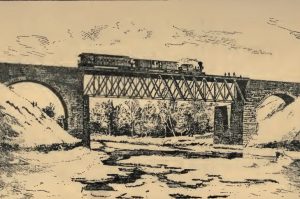 Through the centuries, new designs were developed to build things we needed. As the railroad moved across the nation, track laying came across deep gorges and flat plains. Of course, the flat plains were easy to deal with, and trains could simply go around any hills in the area, but the rivers and gullies were a bigger problem. They needed bridges, and so Charles Collins and Amasa Stone jointly designed a bridge to be used at Ashtabula, Ohio. It was the first Howe-type wrought iron truss bridge built. Collins was worried about the bridge, thinking that it was “too experimental” and needed further evaluation. Nevertheless, higher powers prevailed, and the bridge was built. Collins had been right to be concerned. The bridge lasted just 11 years before it collapsed.
Through the centuries, new designs were developed to build things we needed. As the railroad moved across the nation, track laying came across deep gorges and flat plains. Of course, the flat plains were easy to deal with, and trains could simply go around any hills in the area, but the rivers and gullies were a bigger problem. They needed bridges, and so Charles Collins and Amasa Stone jointly designed a bridge to be used at Ashtabula, Ohio. It was the first Howe-type wrought iron truss bridge built. Collins was worried about the bridge, thinking that it was “too experimental” and needed further evaluation. Nevertheless, higher powers prevailed, and the bridge was built. Collins had been right to be concerned. The bridge lasted just 11 years before it collapsed.
On December 28, 1876, a Lake Shore and Michigan Southern Railway train…the Pacific Express left New York. It struggled along through the drifts and the blinding storm. The train was pulling into Ashtabula, Ohio, shortly before 8:00pm on December 29, 1876, several hours behind schedule. The eleven cars were a heavy burden to the two engines. The leading locomotive broke through the drifts beyond the ravine, and rolled on across the bridge at Ashtabula at less than ten miles an hour. The head lamp could barely be seen because the air was thick with the driving snow. The leading engine reached solid ground, and the engineer had just given it steam…when something in the undergearing of the bridge snapped.
What followed was a horror beyond horrors…not only for the victims, but for the rescuers as well…maybe even more so for the rescuers. As the bridge crumbled beneath the weight of the train, the train and its 159 passengers fell 70 feet into the river below. More than 90 people, passengers and crew, were killed when the train hit the river and ignited into a huge ball of flames. Only the lead engine escaped the fall. As the bridge fell, the engineer gave it a quick head of steam, which tore the draw head from its tender, and the liberated engine shot forward and buried itself in the snow. The engineer escaped with a broken leg. The proportions of the Ashtabula horror are still only approximately known. Daylight, brought with it the opportunity to find and count the saved. It also revealed the fact that two out of every three passengers on the train were lost. Of the 160 passengers who the injured conductor reports as having been on board, fifty nine were found or accounted for as surviving. The remaining 100, burned to ashes or shapeless lumps of charred flesh, were lying under the ruins of the bridge and train. Every possible element of horror was there. First came the crash of the bridge, the agonizing moments of suspense as the seven laden cars plunged down their fearful leap to the icy riverbed. Then the fire, that devoured all that had been left alive by the crash. The water that gurgled up from under the broken ice brought with it another form of death. And finally, the biting blast of freezing air filled with snow, that froze those who had escaped the water and fire.
For the rescuers, the horror had just begun. I can’t think of anything worse than seeing those bodies after they were horribly mangled, drowned, and burned…some beyond recognition, some completely cremated. The number of persons killed cannot be accurately stated, because it is not known exactly how many there were on the train. It is supposed that some of the bodies were entirely consumed in the flames, as well. The official list of those killed and those who have died of their injuries, gives the number as fifty five, but it is suspected to be somewhat higher. There is no death list to report…and in fact, there can be none. There are no remains that can ever be identified. The three charred, shapeless lumps recovered were burned beyond recognition. For the rest, there are piles of white ashes in which were found the crumbling particles of bones. In other places masses of black, charred debris, half under water, which may contain fragments of bodies, but nothing that resembled a human body. It is thought that there may have been a few corpses under the ice, as there were women and children who jumped into the water and sank, but none have been recovered. Periodically, as people began looking for people that were missing around the country, and they were able to place them, as possibly on the train, more supposed victims have been identified…at least there is the possibility that they were a victim.
The Ashtabula, Ohio Railroad Disaster, often referred to simply as the Ashtabula Disaster or the Ashtabula Horror, was one of the worst railroad disasters in American history. The event occurred just 100 yards from the railroad station at Ashtabula, Ohio. It’s topped only by the Great Train Wreck of 1918 in Nashville, Tennessee. Charles Collin, the chief engineer, who knew as few men did the defects of that bridge, but was powerless to repair them, had been listening for this very crash for years. Collins, locked himself in his bedroom and shot himself while the inquest was in progress rather than tell the world all he believed he knew. Collins was found 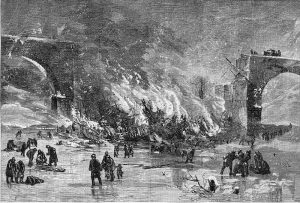 dead in his bedroom of a gunshot wound to the head. He had tendered his resignation to the Board of Directors the previous Monday. Collins was believed to have committed suicide out of grief and feeling partially responsible for the tragic accident, however, a police report at the time suggested the wound had not been self inflicted. Documents discovered in 2001 and an examination of Collins’ skull suggest that he had indeed been murdered. Amasa Stone committed suicide seven years later after experiencing financial difficulties with some foundries he had interests in, suffering from severe ulcers that kept him from sleeping, and scorn from the public over the disaster.
dead in his bedroom of a gunshot wound to the head. He had tendered his resignation to the Board of Directors the previous Monday. Collins was believed to have committed suicide out of grief and feeling partially responsible for the tragic accident, however, a police report at the time suggested the wound had not been self inflicted. Documents discovered in 2001 and an examination of Collins’ skull suggest that he had indeed been murdered. Amasa Stone committed suicide seven years later after experiencing financial difficulties with some foundries he had interests in, suffering from severe ulcers that kept him from sleeping, and scorn from the public over the disaster.
 Life in the home of my youth had many facets, as I’m sure most homes do. There was work to be done, and rules to be followed, but there was also lots of joy and goofiness. My mother, Collene Byer Spencer, was the type of person who might do just about anything. We sometimes simply didn’t know what to expect. I’m sure part of it was from her own upbringing, because she would try to get us to sing songs with her, such as “Keep on the Sunny Side” which was designed to start our day in a happy way, or to ease the tension in a stressful one. If we just couldn’t be made to laugh, “Keep on the Sunny Side” was her first line of defense, usually followed by something goofy she said or did that would make us laugh in spite of ourselves and our sour mood. I suppose she had to come up with something, because life with five teenaged girls and the drama that went with it could be a challenge. Mom just wanted her girls to be happy and to know the joy that simply being alive brings. I can’t say that her plans always worked, because some of us could be a stubborn lot…ok, mostly me, but my sisters too. Still, I think of the five of us, I was probably the most bull headed. You can ask my sisters, and I think they will agree with me…possibly to remove any stigma of stubbornness from themselves, but in realty, I do think I was probably the most stubborn of us all.
Life in the home of my youth had many facets, as I’m sure most homes do. There was work to be done, and rules to be followed, but there was also lots of joy and goofiness. My mother, Collene Byer Spencer, was the type of person who might do just about anything. We sometimes simply didn’t know what to expect. I’m sure part of it was from her own upbringing, because she would try to get us to sing songs with her, such as “Keep on the Sunny Side” which was designed to start our day in a happy way, or to ease the tension in a stressful one. If we just couldn’t be made to laugh, “Keep on the Sunny Side” was her first line of defense, usually followed by something goofy she said or did that would make us laugh in spite of ourselves and our sour mood. I suppose she had to come up with something, because life with five teenaged girls and the drama that went with it could be a challenge. Mom just wanted her girls to be happy and to know the joy that simply being alive brings. I can’t say that her plans always worked, because some of us could be a stubborn lot…ok, mostly me, but my sisters too. Still, I think of the five of us, I was probably the most bull headed. You can ask my sisters, and I think they will agree with me…possibly to remove any stigma of stubbornness from themselves, but in realty, I do think I was probably the most stubborn of us all.
I remember Mom sometimes making goofy faces, or acting in some outlandish way just to make the moment less stressful. Sometimes I think I should have taken note of that plan more in my life. I find that I have a tendency to be rather serious…possibly because I am a thinker, and usually deep in thought about one thing or another. Maybe cutting loose and doing something outlandishly funny would be good for me. It always seemed to make Mom a happy person. It’s not that I’m not happy either, just that I don’t usually show it in a big way…and sometimes I wish I could cut loose that way. Sometimes, I think my life is too serious in nature, too often.
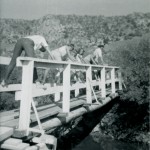
I think my parents tried to do things that would make us laugh. Things like a bottoms up picture on a bridge to get a giggle out of everyone. Yes, that’s how they labeled it. Often times it worked, and continues to work now, whenever we look at the picture. It’s like a way of continuing their goofing off into the time of our lives when they are no longer with us. Who knew that those funny memories would serve to bring so much joy and happiness in our later years. I think we sometimes let our lives get far to serious. We all need to take a page out of my parents book, and cut loose sometimes. The longer my parents are gone, the more I truly understand just how very wise they were. It is my hope that I can grow to be as wise as they were. I love you Mom and Dad.
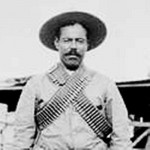 One day in mid 1916 or early 1917, my great uncle, John Spare, who would marry my great aunt, Mina Schumacher on January 8, 1921, was involved in an altercation along the Mexican border, while he was serving in Company B of the North Dakota National Guard. John had enlisted on June 30, 1916 at the age of just 17 years, and his company was assigned to the United States/Mexican border, as we were in the middle of a war with Mexico…really this was border patrol, because there were some pretty dangerous characters running around Mexico, terrorizing the people. One of the most notorious was Pancho Villa. The viciousness of José Doroteo Arango Arámbula…better known as Pancho Villa, was well documented. In a story told by a survivor of his first raid on March 7, 1916, the ruthlessness of this villain is made clear. Pancho Villa and 600 of his renegade followers rode into Columbus, Mexico (population 350) at four o’clock on that morning, riding horses and mules stolen from the Calvary at Camp Turlong just across the border. The camp was the headquarters for the 13th Calvary, and there were about 120 soldiers stationed there. Pancho and his men stole everything of value in the town, and set fire to all its buildings. Many merchants were killed, but the townspeople resisted so strongly that Pancho lost 100 men. He nevertheless, escaped to ride again and continue his raids on both sides of the border.
One day in mid 1916 or early 1917, my great uncle, John Spare, who would marry my great aunt, Mina Schumacher on January 8, 1921, was involved in an altercation along the Mexican border, while he was serving in Company B of the North Dakota National Guard. John had enlisted on June 30, 1916 at the age of just 17 years, and his company was assigned to the United States/Mexican border, as we were in the middle of a war with Mexico…really this was border patrol, because there were some pretty dangerous characters running around Mexico, terrorizing the people. One of the most notorious was Pancho Villa. The viciousness of José Doroteo Arango Arámbula…better known as Pancho Villa, was well documented. In a story told by a survivor of his first raid on March 7, 1916, the ruthlessness of this villain is made clear. Pancho Villa and 600 of his renegade followers rode into Columbus, Mexico (population 350) at four o’clock on that morning, riding horses and mules stolen from the Calvary at Camp Turlong just across the border. The camp was the headquarters for the 13th Calvary, and there were about 120 soldiers stationed there. Pancho and his men stole everything of value in the town, and set fire to all its buildings. Many merchants were killed, but the townspeople resisted so strongly that Pancho lost 100 men. He nevertheless, escaped to ride again and continue his raids on both sides of the border.
In haste, the United States sent soldiers to guard the borders. Unfortunately they were not well equipped, 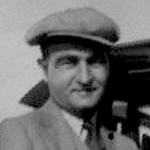 because of the unpreparedness of the military machine at the time. Many of those men, including my great uncle’s company were sent down there without ammunition, and told that those who had ammunition would fight an attack if it came, while the others would dive under the bridge until the attack was over. They neglected to tell them that none of them had ammunition, and the men did not know that until all of them jumped under the bridge at the same time. It was then that the horrible truth was revealed. The hope, apparently, was to make Pancho think this was a large army to be reckoned with, in the hope that they would not try to attack them. They sorely misjudged the ruthlessness of this man, but the good news was that Pancho and his men were already in a gun fight with the 13th Calvary, so they took little notice of this small band of men hiding under the bridge, hoping that the villain and his men didn’t circle around and come back. I don’t know how long Great Uncle John was stationed there, but it is my guess that one day was too much…unless they were given some ammunition, that is.
because of the unpreparedness of the military machine at the time. Many of those men, including my great uncle’s company were sent down there without ammunition, and told that those who had ammunition would fight an attack if it came, while the others would dive under the bridge until the attack was over. They neglected to tell them that none of them had ammunition, and the men did not know that until all of them jumped under the bridge at the same time. It was then that the horrible truth was revealed. The hope, apparently, was to make Pancho think this was a large army to be reckoned with, in the hope that they would not try to attack them. They sorely misjudged the ruthlessness of this man, but the good news was that Pancho and his men were already in a gun fight with the 13th Calvary, so they took little notice of this small band of men hiding under the bridge, hoping that the villain and his men didn’t circle around and come back. I don’t know how long Great Uncle John was stationed there, but it is my guess that one day was too much…unless they were given some ammunition, that is.
Great Uncle John survived the war, and returned to Fargo, North Dakota, where he married my Great Aunt Mina. While he would still serve in the military for a long time, their lives would be happy and blessed with a daughter, Pauline Jessie Spare, who always went by Paula, on March 23, 1922. Pancho Villa continued to wreak havoc in Mexico, and along the border, until 1920, when he retired. For whatever reason, he was given a large estate, which he turned into a Military Colony for his formers Villistas, as his men a become known. Then, in 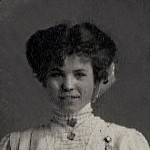 1923, Pancho decided to once again involve himself in Mexican politics, and on July 20, 1923, when he was killed by an assassin, who had probably been hired by the president of Mexico, Álvaro Obregón. When I read that Pancho Villa had been assassinated on this day in 1923, I remembered that Great Uncle John Spare had once had a close encounter with him, and I wondered how he and Great Aunt Min felt when they heard the news. Parral, Chihuahua, Mexico was a long way from Fargo, North Dakota, and a number of years had passed, so maybe they gave it little thought, or maybe they breathed a sigh of relief, knowing what kind of a man he was, and just how close Great Uncle John had come to losing his life that day, along the United States and Mexican Border.
1923, Pancho decided to once again involve himself in Mexican politics, and on July 20, 1923, when he was killed by an assassin, who had probably been hired by the president of Mexico, Álvaro Obregón. When I read that Pancho Villa had been assassinated on this day in 1923, I remembered that Great Uncle John Spare had once had a close encounter with him, and I wondered how he and Great Aunt Min felt when they heard the news. Parral, Chihuahua, Mexico was a long way from Fargo, North Dakota, and a number of years had passed, so maybe they gave it little thought, or maybe they breathed a sigh of relief, knowing what kind of a man he was, and just how close Great Uncle John had come to losing his life that day, along the United States and Mexican Border.
![10923213_440170332807925_8150083029748186127_n[1]a](https://carynschulenberg.com/wp-content/uploads/2015/03/10923213_440170332807925_8150083029748186127_n1a-150x150.jpg) The past few years have brought much change in my Aunt Bonnie McDaniels’ life. About two and a half years ago, her husband, my Uncle Jack McDaniels left us for Heaven. That was the most significant and the saddest change for sure. Uncle Jack had been the love of her life, and his passing marked the end of an era for her. Her children and grandchildren have stepped in to help her cope with the feelings of saddness and loss, but then they were always there for her and Uncle Jack too.
The past few years have brought much change in my Aunt Bonnie McDaniels’ life. About two and a half years ago, her husband, my Uncle Jack McDaniels left us for Heaven. That was the most significant and the saddest change for sure. Uncle Jack had been the love of her life, and his passing marked the end of an era for her. Her children and grandchildren have stepped in to help her cope with the feelings of saddness and loss, but then they were always there for her and Uncle Jack too.
Another change that has impacted Aunt Bonnie’s life recently is the fact that the bridge that she used to get to town whenever she went was burned down when someone set off fireworks on it’s wooden surface. I couldn’t believe that the state would not rebuild that bridge, because it made life very inconvenient for a number of people. For a long time, to go to town, Aunt Bonnie ![1907760_440164256141866_7582873451092878696_n[1]](https://carynschulenberg.com/wp-content/uploads/2015/03/1907760_440164256141866_7582873451092878696_n1-150x150.jpg) had to take the back roads and let me tell you, it is a much longer drive. Of course, the biggest concern was the ability to evacuate in the event of a fire. That made me want to keep Aunt Bonnie in prayer for protection every day. After a time, and probably many complaints, the bridge was rebuilt, but I’ll still keep her in prayer.
had to take the back roads and let me tell you, it is a much longer drive. Of course, the biggest concern was the ability to evacuate in the event of a fire. That made me want to keep Aunt Bonnie in prayer for protection every day. After a time, and probably many complaints, the bridge was rebuilt, but I’ll still keep her in prayer.
These days, Aunt Bonnie is beginning to branch out some, and that makes me very happy for her. Recently, her family took the opportunity to go to Artisan Alley, and spend the evening painting. Artisan Alley is a newer place in Casper, where you can take a group of people in and paint…with a little instruction, thankfully. They also have wine if you want it. I have not been there yet, but everyone I have talked to who has said it is a lot of fun. Looking at Aunt Bonnie, who looks more and more like her mother every day, I can see that she enjoyed herself immensely. I am always glad ![10407841_440615822763376_2975648401274259886_n[1]](https://carynschulenberg.com/wp-content/uploads/2015/03/10407841_440615822763376_2975648401274259886_n1-150x150.jpg) when the children step in and take their widowed parent to do things. It keeps their parent young, and it will always be a blessing for the children too.
when the children step in and take their widowed parent to do things. It keeps their parent young, and it will always be a blessing for the children too.
From what I’m told, the family had such a good time painting, that the next planned adventure is going to be pottery. My Aunt Bonnie has long been a bit of the artist in the family. Her cakes are famous around here, and even beyond our town. That said, I think she will really excel at these new artistic ventures, and who knows, maybe she will take up the arts on her own time. Famous artists don’t necessarily have to start out young. There is always time to start something new. Today is Aunt Bonnie’s birthday. Happy birthday Aunt Bonnie!! Have a great day!! We love you!!
 My great aunt, Mina Albertine Schumacher, who went by Minnie as a child, but Min for most of her adult life, married John Clark Spare in Fargo, North Dakota on January 8, 1921. In the years preceding their marriage, John had enlisted in the North Dakota National Guard, Company B, at the age of 17 years. His company was assigned to the Rio Grande River Patrol on the Mexican border at Mercedes, Texas. Company B was patrolling one day, and John had an empty gun, because at that point, there was not enough ammunition to go around. Basically, the men who had loaded guns would have to cover the ones who did not, in the event of anything illegal happening along the border. I suppose that was the only thing that they could do, but I have to tell you that I would not feel very comfortable being one of those guys who did not have any ammunition at the border between Mexico and the United States. I realize that these days that border is probably more dangerous than it was then, but maybe not. Many of the outlaws from both countries ran to the other country to hide out from the law in their own country.
My great aunt, Mina Albertine Schumacher, who went by Minnie as a child, but Min for most of her adult life, married John Clark Spare in Fargo, North Dakota on January 8, 1921. In the years preceding their marriage, John had enlisted in the North Dakota National Guard, Company B, at the age of 17 years. His company was assigned to the Rio Grande River Patrol on the Mexican border at Mercedes, Texas. Company B was patrolling one day, and John had an empty gun, because at that point, there was not enough ammunition to go around. Basically, the men who had loaded guns would have to cover the ones who did not, in the event of anything illegal happening along the border. I suppose that was the only thing that they could do, but I have to tell you that I would not feel very comfortable being one of those guys who did not have any ammunition at the border between Mexico and the United States. I realize that these days that border is probably more dangerous than it was then, but maybe not. Many of the outlaws from both countries ran to the other country to hide out from the law in their own country.
On that day, John was patrolling near the bridge by the encampment, with his empty gun. Suddenly, a herd of horses was seen thundering toward them. Behind the herd was Pancho Villa and his gang of bandits. The gang was in a gun fight with the men from the Third Cavalry, from whom the gang had stolen the horses. The time had come for the border patrol to do their duty. It would be the job of the ones with the ammunition to engage the enemy and assist the Cavalry. The remainder of the men would need to dive under the bridge for cover. The men immediately prepared to take their necessary positions, and with one accord, all of the men of the border patrol dived under the bridge. Unbeknownst to the men, at least until that moment, they all had unloaded guns!! While that might seem like a funny thing to see all those men diving under that bridge because they did not have the ammunition to fight in the battle that was looming down on them, my guess is that it would also be a horrifying situation to the men hiding under the bridge hoping the battle would continue to go on down the road, and not circle back.
Following his time as part of the border patrol, John was called to the Guard full time, and assigned to guard the Fargo Armory, just as bombs were being placed at strategic points around the country to blow them up if it became necessary. I think it is a bit ironic that on his first assignment, John had no ammunition, and at his second assignment, when he was just going on 19 years of age, he was guarding a building that held larges stores of ammunition. I have to think that he must have thought to himself, “Where was all this ammunition when we were at the border?” John’s company would be taken into the Federal Army as the United States entered World War I. John would later re-enlist and fight in both world wars before he finally decided that he had served his time. I’m sure my Great Aunt Min was glad when he came home for good.
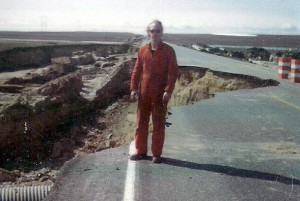 I am often amazed at the changes in our weather. No, I don’t buy into the Global Warming thing, which is ridiculous, but I do think our weather runs in cycles. We have droughts and then wet years. We have years with little snow and years with huge spring runoffs. Back in the 1980’s, while Bob was working at Shirley Basin in the Uranium mines, we has one of those huge runoff years. It had snowed an awful lot that year, especially in the mountains, and when Spring arrived, there was so much water that it caused part of the road he drove to and from work to wash out. I know this kind of thing happens periodically, but this was really our first experience with anything like this.
I am often amazed at the changes in our weather. No, I don’t buy into the Global Warming thing, which is ridiculous, but I do think our weather runs in cycles. We have droughts and then wet years. We have years with little snow and years with huge spring runoffs. Back in the 1980’s, while Bob was working at Shirley Basin in the Uranium mines, we has one of those huge runoff years. It had snowed an awful lot that year, especially in the mountains, and when Spring arrived, there was so much water that it caused part of the road he drove to and from work to wash out. I know this kind of thing happens periodically, but this was really our first experience with anything like this.
It was quite a big deal. They had to make a way for the men to get around there so they could get to work and I believe that for a time, that meant taking the long way around, adding time to the drive home. Thankfully this was a big enough issue that the highway department got things fixed in a big hurry, but for a time it was quite the novelty. I think probably every person that worked at the mines had their picture taken at the site of the washout. It was the only washout that occurred in the years that Bob worked at Shirley Basin, even though we have had other bad flood years since that time.

One such washout, or in this case, landslide, happened in May 2011, when a huge hillside near Jackson, Wyoming blocked Highway 26/89 for 10 days. And then there was the flood that practically wiped out Kaycee, Wyoming in August 2002, wiping out one of the bridges on I-25. Even though these situations were not the first ones I had ever heard of, they still shocked me in a big way. Wyoming is normally such a dry state, that to think of floods and landslides is unusual. It’s just something that can happen in any state if the conditions are right.

